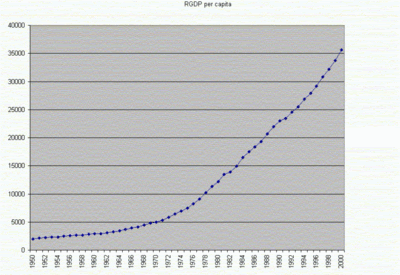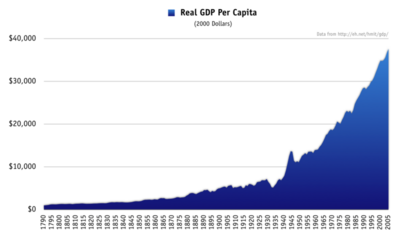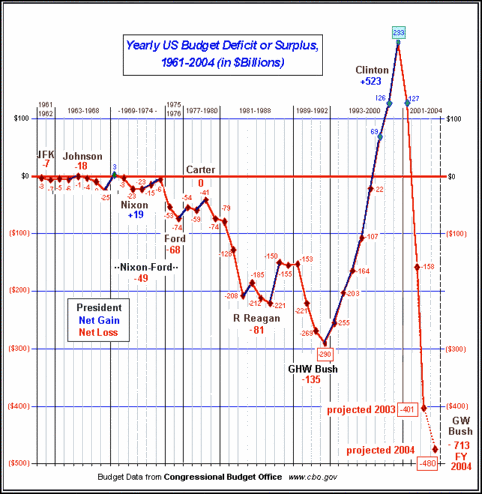(cross-posted at Deny My Freedom, Daily Kos, and My Left Wing)
Back in the good ‘ole days of the blogosphere, there used to be a term used universally throughout that was meant as a way to distinguish us from the Kool-Aid drinkers on the other side and the corporate media who tried to shine a light away from the truth. We called ourselves the reality-based community, a place where we would not hide from the facts, regardless of what they were. However, it’s a term that has become increasingly sparse these days, and maybe, sadly, for good reason. Today, Kos readily linked to a misleading ThinkProgress story on the budget deficit. Its content?
Today, the Office of Management Budget projected a $296 billion federal deficit for fiscal year 2006. Bush held a press conference arguing that this is a vindication of his economic policies.
Actually, it would be the fourth largest deficit of all time. Here’s the top five:
- 2004 (George W. Bush) $413 billion
- 2003 (George W. Bush) $378 billion
- 2005 (George W. Bush) $318 billion
- 2006 (George W. Bush) $296 billion (projected)
- 1992 (George H. W. Bush) $290 billion
That’s fine and dandy…except that it’s only one side to a multifaceted story.
One thing that these numbers fail to account for is the effects of inflation. If you put nominal (raw, unadjusted) numbers side by side in economics, you will almost always see a trend in one direction, whether it be up or down. For example, look at this graph of nominal GDP measured in the last 50 years:

It shows a steady increase upwards. GDP, which stands for gross domestic product (a measure of domestic output within the country by domestic factors of production), is at its highest nominal levels under Bush. One must think the economy is doing just fine, right? Of course not; almost any economic trend might show similar movement. Furthermore, one has to account for inflation in such movements. However, the problem with inflation is that depending on what your base year is, the measurements of economic factors will be largely predicated upon the base year that you use for valuing the dollar at. Here’s a picture of real (adjusted for inflation in this case; it refers to anything that normalizes measurement across time and other effects) GDP, based on 2000 dollars:

As you can see, the general trend is there. However, if one were to measure GDP in 1800 dollars, for example, the same trend would probably be present, but it would be less pronounced than it is now. If you visit this website and determine how much $1 dollar in 1800 would be worth in 2005 dollars, you’ll find that, depending on what measure you use, it will range from being worth $15.45 to upwards of $26,000.
The same lesson can be applied to the budget deficit. One problem with the spreadsheet that ThinkProgress referenced is that it has everything listed in nominal terms. There is absolutely no adjustment for real measurement, making it prime for presenting one side of the story. Indeed, if you look at the following graph of the nominal budget deficit in the last 45 years or so, you will come to the same conclusion: Bush has the worst fiscal record of any president by far (the graph only measures up until 2004, but it gives you the general idea).

However, with regards to the budget deficit, perhaps the most important measure is the percentage of GDP that the budget deficit makes up. After looking around on the White House website (which has an awful search engine, making it difficult to find this data), I was able to find relevant data with regards to inflation-adjusted numbers for the budget deficit and the budget deficit as a percentage of GDP. Using 2000 dollars, Bush’s deficits in 2004 and 2003 are still the highest on record. However, his father’s budget deficit in 1992 is now third-highest, followed by Ronald Reagan in 1983 and the first President Bush in 1991 (on this table, the 2006 estimate is old and hasn’t been updated to reflect today’s $296 billion number). If one were to use 1980 dollars as a baseline, though, Reagan’s budget deficits would be the highest in real terms. As a percentage of GDP, though, Bush’s budget deficits are nowhere near the top – this is dominated by Reagan in 1983, 1985, 1986, and 1984, respectively (I am ignoring the numbers for World War II, which were extraordinary circumstances). When one looks at the budget deficit as a percentage of GDP, there is no need to make a subjective conversion into real terms; the percentage itself is reflective of the relative value of the budget deficit to GDP.
For even more insightful analysis and graphs, one should visit this website, which has plenty of additional graphs and analysis with regards to the budget deficit, the national debt, and other economic factors. I know that many in the blogosphere believe Bush to be the worst president ever in every aspect possible, but it’d be best if we stuck to the relevant facts when making the assessment.

Yeah, it’s easy to make these numbers even worse than they are, and even worse than we need them to be. Reality is scary enough.
Incidentally, have you met my friend FRED? The St. Louis Fed maintains a terrifically useful website with as much economic data as you could wish for (including the CPI and GDP deflator. Even the Federal deficit. Might save you from that pesky White House web site.